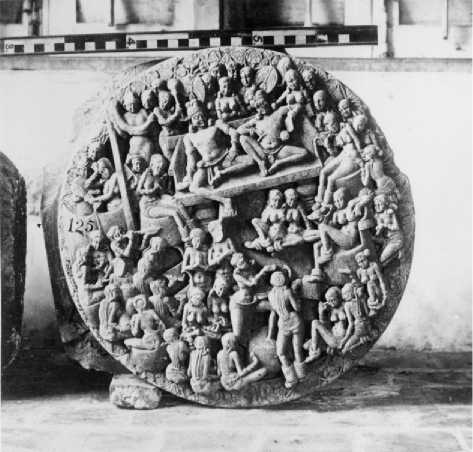A great mastery of the peculiar properties of stone in early Indian art is found in the Buddhist relief sculptures of Amaravati. The stone carvers’ yard at this site must have been an art academy where leading sculptors practiced and taught apprentices during the successive phases of construction, enlargement and renewal, c. second to first century BCE - third to fourth century CE. The soft contours of Andhra art style can be seen at numerous Buddhist sites along the East Coast and up the great river valleys, at Nagarju-nakonda, Ghantasala, Jaggayapeta, Ramatirtham, Salihundam, Sankaram. Bavikonda. Thotlakonda, and many others. While high aesthetic levels were achieved at a number of Andhran Buddhist sites, especially Nagarjunakonda (third to fourth centuries), at Amaravati in the second to third centuries CE quite exceptional levels of stone carving skills were paired with dynamic visions of iconic incidents from the Buddha’s life. They have been compared with the highest aesthetic levels reached in classical Greek relief sculpture (cf. the Alexander sarcophagus, now in the Archaeological Museum, Istanbul or the side panels of the Pergamon altar, in the Pergamon Museum, Berlin).
Typically the main figure or object in an Amaravati sculpture in high relief is depicted on a larger scale but off-center in the scene, while supporting figures move in a clockwise swirl around that focal point (Figure 5). The concentration on the focal point is emphasized by the orientation of each member of the scene and the angles their bodies present to the viewer, by many graceful contrasts among arm and leg positions and by draperies in movement. At their best, the Amara-vati sculptors produced elegant solutions to the perennial challenges in relief sculpture. For example, worshipping figures are presented partly, largely and entirely from the back following the rhythms of this sweeping circular vision; persuasive depictions are made of human anatomy and its relative proportions;

Figure 5 Amaravati Buddhist sculpture carved in high relief (from the inner face of the stupa railing). By courtesy of the British Museum, second to third century CE.
There is strikingly effective foreshortening of the feet of humans and animals, linked technically with an extraordinary mastery of the diminishing scale of the bodies of horses, elephants and humans emerging from the stone at a three-quarter angle in high relief; in crowded scenes, bodies and objects are skillfully superimposed in varying depths of relief while individual components are in movement.
Figure 4 Is one of many surviving drum slabs which, though not identical, nonetheless give a general idea of the appearance of the Great Amaravati Stupa at its peak, c. second to fourth century CE, and of its principal decorative elements. This monument of some 49 m in diameter and perhaps some 16 m in height, together with its railing, was the focus of an immense amount of superb Buddhist sculpture in high relief as well as (from c. the third century onwards) some standing Buddha figures in the round. Relief sculptures were placed on the outer and inner surfaces of the railings; on the drum, especially on the four ayaka platforms projecting from the drum opposite the gateways; and on the lower half of the dome-shaped superstructure.
There is an unresolved debate among art historians as to whether there was an aniconic phase in early Buddhist art, succeeded by an iconic one and whether this marked a change in Buddhist thought and the worship addressed to the person of the Buddha as reflected in his images. Meanwhile, it can be noted that depictions of the Buddha go back at least to the first and possibly second century BCE (e. g., the Bimaran reliquary) and that such representations overlap in time with sculpture in which his presence was denoted symbolically through his footprints, an empty throne, the Bodhi tree, and the stupa itself. At Amaravati there are many such sculptures of the second to third century CE showing veneration being offered by monks and laity to these symbols of the Buddha’s presence, while standing Buddha figures carved in the round appear there c. early third century CE. On a reduced scale, the decorative scheme of the Amaravati Mahachaitya was reproduced on the very numerous smaller stupas nearby extending over the plain on the south bank of the Krishna River. The royal city of the Satavahanas, Dhanyakataka lay close by with a wharf on the riverbank testifying to the linkages between royal patronage, Buddhism and trade.
The deeper roots of Amaravati and many other Andhra Buddhist sites in prehistoric and protohistoric sacred geography also reveal themselves in the presence of numerous megalithic burials within and close by the stupa area. Evidence at other Andhra sites indicate that megalithic-type burials continued to be practised up to c. third century CE, clearly overlapping with and at least in some cases interacting with Buddhism. A total of 214 megalithic burials sites have been identified in Andhra - some of them containing hundreds of individual locations - and c. 118 early Buddhist sites were established there before the third century CE. There appears to be a striking correlation between these sacred geographies (Figure 2). Earlier scholars noted the occurrence of megalithic sites within such iconic Buddhist sites as Amaravati, Nagarjunakonda, Yelleshwaram, and Jaggayapeta and some linear cultural continuity has been proposed from late prehistory into the early historical era. This is well founded and important. But this article argues that is even more significant to recognize the ‘contemporaneity’ of megalithic burial practices and early Buddhism in Andhra over c. a further four centuries and that there are sites where there is evidence of their interaction, as in the megalithic burial chambers and their art at Chagatur (Mahaboobnagar District, Andhra) as well as the burial chambers inside stupas of Northwest India. Such evidence compels one to consider anew the complexities of cultural assimilation and change taking place in early Buddhist societies to which late prehistoric and early historic archaeology, art and inscriptions provide the only doorways.




 World History
World History









